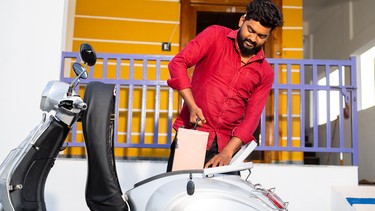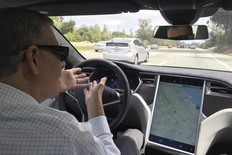Electric scooters sales in India just quadrupled
The country saw sales of about 640,000 battery-powered two-wheelers in 2022, an increase of 400 per cent from the year prior

Article content
Scooters are big business in India. Where we middle-class North Americans drive around in Toyotas and Teslas, our middle-class equivalents in the world’s now-most-populous country scoot around on Hondas and Suzukis. In fact, 16 million scooters were sold there last year alone, and the buzzy little two-wheelers represent fully 70 per cent of all vehicles clogging Indian streets.
Advertisement 2
Article content
And last year, four per cent of those 16 million — some 640,000 — were fully battery-powered, completely eschewing any form of internal combustion. That’s up from just one per cent the year previous. More incredibly, according to The Economist, some 40 per cent of the 632,000 three-wheeled rickshaws sold last year — the ubiquitous “tuk-tuk” taxis — were similarly electrified, and that is expected to reach almost 100 per cent by the end of the decade.
Combined, two- and three-wheelers accounted for no less than 92 per cent of all electrified vehicles registered in India in 2022, and, compared to the paltry 1.3 per cent of car sales that were plug-ins, the car industry would seem to be lagging far behind.
Recommended from Editorial
Advertisement 3
Article content
All is, of course, not perfect. For instance, according to The Economist, the surge has, as in so many countries, been encouraged by generous subsidization. But this being a country famous — at least in motorcycling terms — for its “informal” economy, most of those 250,000 new electric rickshaws are actually powered by lead-acid batteries, which India builds in large numbers for car starters. And, like all countries looking to encourage EV sales, India is woefully short of a public charging infrastructure, hence why scooters and rickshaws, both mostly home-bound transportation, are the big growth industry.
Nonetheless, there are ample incentives for India to wean itself off fossil-fuelled two-wheelers. The first, as per The Economist, is purely economic: India imports nearly 85 per cent of its crude, a number the world’s leading business magazine says accounts for 24 per cent of its “import bill.”
Advertisement 4
Article content

The second is environmental. Many of those scooters, especially older versions, are powered by smoky two-stroke engines which burn oil along with gasoline, their trailing blue plumes literally resplendent with unburned hydrocarbons. Two-stroke engines are also inefficient relative to their power output, so their carbon production is outsized.
Also, one should not mistake this rapid growth of electrified scooters in one country with the popularization of battery-powered motorcycles everywhere. Full-sized plug-in motorcycles — equivalent to 600-cc and larger ICE-powered versions — represent but a microscopic fraction of global motorcycle sales.
The problem is weight and efficiency. Unlike cars which can (mostly) hide the weight of their 1,000-pound batteries in the sub-floor, the batteries required for long-distance touring motorcycles turn two-wheelers into seriously unwieldy behemoths. India’s demand for electrified scooters for localized transport therefore should not be mistaken for widespread adoption of battery-powered motorcycles. Nonetheless, not only is this good news for India, but it is a rapid growth that should be emulated everywhere.


















